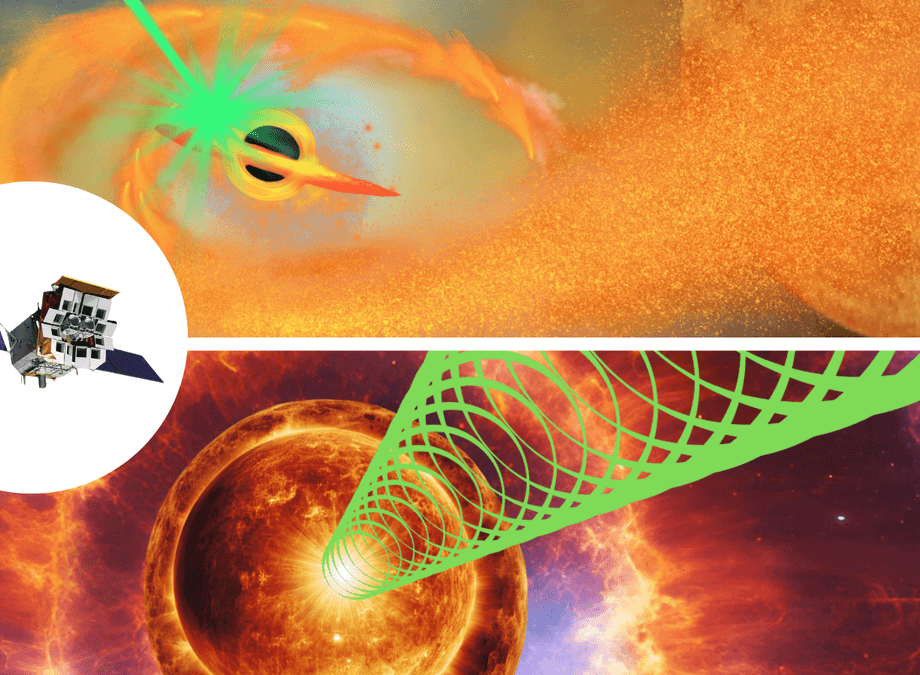China’s Einstein Probe Sheds Light on Mysterious Cosmic Explosions
In a groundbreaking discovery, China’s Einstein Probe (EP) satellite has detected a previously unknown type of cosmic explosion, revealing a hidden population of faint and fast X-ray transients that occur during the death throes of massive stars. This finding, published in Nature Astronomy in June 2025, challenges established theories of stellar collapse and opens a new chapter in high-energy astrophysics. The event, designated EP240414a, was observed as a fleeting 150-second X-ray flare from a star located 4 billion light-years away, and was later linked to a rare supernova, SN 2024gsa. The discovery not only bridges the gap between traditional supernovae and powerful gamma-ray bursts (GRBs) but also demonstrates the unique capabilities of the Einstein Probe’s advanced technology.
- China’s Einstein Probe Sheds Light on Mysterious Cosmic Explosions
- What Did the Einstein Probe Discover?
- How Does the Einstein Probe Work?
- Why Are Fast X-ray Transients Important?
- The Technology Behind the Discovery: Lobster-Eye Optics
- Broader Implications: A New Window on the Dynamic Universe
- International Collaboration and Future Prospects
- In Summary
What Did the Einstein Probe Discover?
The Einstein Probe’s detection of EP240414a marks the first time astronomers have observed a fast X-ray transient (FXRT) directly associated with a supernova. FXRTs are brief, intense flashes of X-ray light that last from seconds to minutes, making them extremely difficult to catch. In this case, the X-ray flare was accompanied by a weak relativistic jet—an outflow of matter moving at nearly the speed of light, but slower and less energetic than those seen in typical GRBs.
Follow-up observations across optical and radio wavelengths confirmed the connection between the X-ray transient and the supernova SN 2024gsa. The event’s unique characteristics—its soft X-ray spectrum, rapid evolution, and association with a weak jet—set it apart from previously known classes of cosmic explosions, such as long-duration GRBs or low-luminosity GRBs. Instead, it points to a new, intermediate category of stellar death, likely involving the collapse of a Wolf-Rayet star (a massive star stripped of its outer layers) with insufficient angular momentum to power a full-fledged GRB.
Professor He Gao of Beijing Normal University, lead author of the study, explains:
“These fast X-ray transients are like cosmic fireworks—bright and fleeting, making them extremely challenging to detect. They resemble ‘gentler versions’ of gamma-ray bursts and might be far more common than we thought. Past missions simply missed them due to limited X-ray monitoring capabilities.”
This discovery not only expands our understanding of how massive stars die but also suggests that such faint, fast transients could be a common, yet previously hidden, feature of the universe.
How Does the Einstein Probe Work?
The Einstein Probe is a state-of-the-art space observatory launched in January 2024 by the Chinese Academy of Sciences, in collaboration with the European Space Agency (ESA), the Max Planck Institute for Extraterrestrial Physics (Germany), and the French space agency CNES. The satellite is uniquely equipped with “lobster-eye” X-ray optics—a technology inspired by the way lobsters see, using reflection rather than refraction to capture light from a wide field of view.
The probe’s primary instrument, the Wide-field X-ray Telescope (WXT), consists of twelve modules that together can monitor nearly one-eleventh of the entire sky in a single glance. This wide coverage is crucial for catching unpredictable, short-lived events like FXRTs. When WXT detects a new X-ray source, the satellite can quickly pivot to target it with its more sensitive Follow-up X-ray Telescope (FXT), allowing for detailed study of the event’s evolution.
Dr. Weimin Yuan, principal investigator of the Einstein Probe, highlights the mission’s capabilities:
“EP240414a showcases Einstein Probe’s ability to uncover new cosmic phenomena. We anticipate many more discoveries about the extreme universe in the future.”
The satellite orbits Earth every 96 minutes at an altitude of about 600 kilometers, enabling it to scan the entire night sky every few hours. Its advanced detectors, including innovative CMOS sensors, provide high sensitivity and rapid response, making it possible to detect and study faint, transient X-ray sources that have eluded previous missions.
Why Are Fast X-ray Transients Important?
Fast X-ray transients like EP240414a are crucial for understanding the most extreme processes in the universe. They are thought to arise during the final moments of massive stars, when the core collapses and triggers a supernova explosion. In some cases, this collapse also launches a jet of material at relativistic speeds, producing a GRB. However, not all jets are powerful enough to escape the star or produce detectable gamma rays.
The discovery of a weak, successful jet in EP240414a suggests that there is a continuum of jet-driven explosions, ranging from ordinary supernovae (with no jet) to powerful GRBs (with strong jets), with events like EP240414a occupying the middle ground. This finding helps bridge the gap between these two extremes and provides new insights into the physics of jet formation, the role of stellar rotation, and the diversity of stellar deaths.
Professor Xiaofeng Wang of Tsinghua University, co-corresponding author of the study, emphasizes the significance:
“This marks Einstein Probe’s first discovery of an X-ray transient linked to a supernova, opening a new era in time-domain high-energy astrophysics. These findings were made possible through close international collaboration.”
By capturing the early, faint X-ray emission from such events, the Einstein Probe enables astronomers to study the dynamics of jet interaction with the surrounding material, the structure of the progenitor star, and the mechanisms that determine whether a jet succeeds or fails.
The Technology Behind the Discovery: Lobster-Eye Optics
The Einstein Probe’s success hinges on its revolutionary lobster-eye optics. Unlike traditional telescopes, which use lenses or mirrors to focus light from a narrow field, lobster-eye optics use arrays of tiny square channels to reflect X-rays from a wide area onto the detector. This design allows the WXT to monitor vast swathes of the sky simultaneously, increasing the chances of catching rare, transient events.
The FXT, modeled after the successful eROSITA X-ray telescope, provides high-resolution follow-up observations. The combination of wide-field monitoring and rapid, sensitive follow-up is a game-changer for time-domain astronomy, enabling the detection and characterization of events that would otherwise go unnoticed.
According to Erik Kuulkers, ESA’s Einstein Probe Project Scientist:
“As soon as we opened the eyes of Einstein Probe to the sky, it found interesting new phenomena. That’s pretty good and should mean that there are a lot more interesting discoveries to come.”
The mission’s international collaboration ensures that data and discoveries are shared with the global scientific community, fostering rapid follow-up and multi-wavelength observations from ground- and space-based telescopes worldwide.
Broader Implications: A New Window on the Dynamic Universe
The Einstein Probe’s discovery of EP240414a is just the beginning. In its first months of operation, the satellite has already detected dozens of transient events, including white dwarfs, neutron stars, black holes, and gamma-ray bursts. Its ability to capture the early X-ray emission from distant explosions offers a new way to study the universe’s most energetic and mysterious phenomena.
One of the mission’s key goals is to help localize the sources of gravitational waves—ripples in spacetime produced by the mergers of black holes and neutron stars. These cataclysmic events often emit X-rays, and the Einstein Probe’s wide gaze can help pinpoint their origins, complementing ground-based gravitational wave detectors like LIGO and Virgo.
The satellite also honors a long tradition of Chinese astronomy. Its name, “Tianguan” in Chinese, pays tribute to the Song Dynasty astronomers who recorded the supernova of 1054, which created the famous Crab Nebula. The mission continues this legacy by pushing the boundaries of our knowledge about the transient and violent universe.
International Collaboration and Future Prospects
The Einstein Probe is a testament to international scientific cooperation. The mission brings together expertise and resources from China, Europe, and beyond. The Max Planck Institute for Extraterrestrial Physics contributed key components to the FXT, while ESA provides ground station support and access to 10% of the mission’s data. French space agency CNES supports real-time data downlink, ensuring rapid dissemination of discoveries.
This collaborative approach accelerates scientific progress and ensures that the entire astronomical community benefits from the mission’s findings. The Einstein Probe is expected to operate for at least three years, with the possibility of extension, and scientists anticipate many more breakthroughs as it continues to scan the dynamic X-ray sky.
Paul O’Brien, Head of Astrophysics at the University of Leicester, underscores the mission’s impact:
“The Einstein Probe’s ability to search for and observe X-ray sources is already having a significant impact on our understanding of the Universe.”
As the mission continues, astronomers hope to uncover more hidden classes of cosmic explosions, deepen our understanding of stellar evolution, and perhaps even solve longstanding mysteries about the origins of black holes, neutron stars, and the most powerful explosions in the cosmos.
In Summary
- The Einstein Probe satellite has detected a new type of cosmic explosion: faint, fast X-ray transients linked to the death of massive stars.
- The discovery of EP240414a, associated with supernova SN 2024gsa, reveals a hidden class of stellar explosions with weak relativistic jets.
- The satellite’s lobster-eye optics and wide-field X-ray vision enable it to catch fleeting, unpredictable events that previous missions missed.
- This finding bridges the gap between traditional supernovae and powerful gamma-ray bursts, challenging existing theories of stellar collapse.
- The Einstein Probe is an international collaboration, with contributions from China, ESA, Germany, and France, and is expected to make many more discoveries in the coming years.
- The mission’s data will help unravel the physics of jet formation, the diversity of stellar deaths, and the origins of gravitational wave events.












